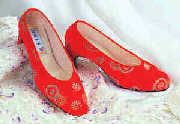 In China, there are many established practices concerning shoes, many of which have become standard life etiquette. For example, shoes are presented to a baby one full month after its birth; newlyweds have to wear wedding shoes at their wedding ceremony; shoes embroidered with the Chinese character fu are often given as birthday presents to elderly people; and at funerals, the children of the deceased have to wear filial shoes. Among the various shoe-related customs, wedding shoes have played an extremely important role in one's marriage since ancient times.
In China, there are many established practices concerning shoes, many of which have become standard life etiquette. For example, shoes are presented to a baby one full month after its birth; newlyweds have to wear wedding shoes at their wedding ceremony; shoes embroidered with the Chinese character fu are often given as birthday presents to elderly people; and at funerals, the children of the deceased have to wear filial shoes. Among the various shoe-related customs, wedding shoes have played an extremely important role in one's marriage since ancient times.
 Presenting shoes when delivering betrothal gifts
Presenting shoes when delivering betrothal gifts
In ancient times, males were referred to as qian (symbol of heaven in the Eight Trigrams, or the eight energies in the t'ai chi martial art), and females, as kun (symbol of earth in the Eight Trigrams). Women's shoes are therefore called kun shoes.
During the Han Dynasty(206BC-220AD), when a woman was getting married, she usually wore a pair of wooden sandals painted with colorful patterns and fastened by colorful ribbons, both of which were seen as auspicious symbols.
During the Southern Dynasty(420-589), if a man was to take a wife, he had to first present to the woman a new pair of silk shoes when delivering betrothal gifts. The custom continued in many places, such as in Ningbo and Yinxian cities of today's Zhejiang Provincein East China, during the dynasty's Guangxu Period. According to the local matrimonial customs at that time, when a marriage was settled, the woman's family would find out the shoe sizes of the man's grandparents and great-grand parents. Then, the woman would painstakingly make elaborate shoes for them. When delivering betrothal gifts, the man would give jewelry, silk, cattle, food, and wine to the woman's family, who would hold a feast to entertain. Afterwards, the woman's family would give the man the self-made shoes in return, which were meant to show their daughter's filial piety to her future in-laws.